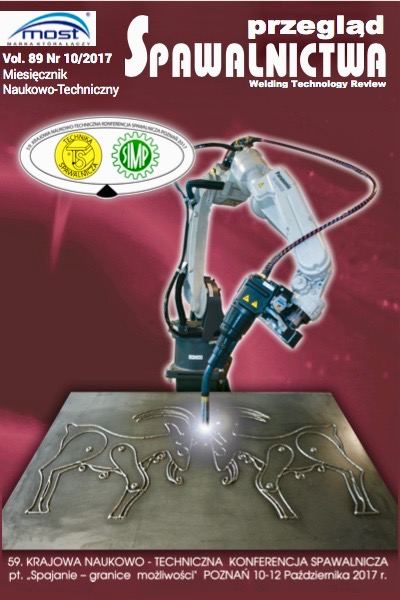Modeling of welding heat source in the hybrid welding process
##plugins.themes.bootstrap3.article.main##
Abstrakt
The rapid development of computer technology now allows for analysis of welding stresses for most welding processes. The types of welding heat sources that are nec- essary to determine the temperature eld during welding are well described. The temperature gradient that occurs during welding is one of the major causes of welding residual stresses that can signi cantly affect the service life of welded joints. Hence, modeling the temperature eld during welding is one of the necessary elements for estimating deformation and stresses in welded constructions. Hybrid welding processes belong to a new group of welding variants that combine most commonly two conventional welding methods, such as laser welding and GMA welding or plasma welding and GMA welding. Modeling of welding residual stresses in this type of welding requires the de nition of a new type of heat source model combining a concentrated stream of energy with the classical heat sources present in the welding arc. The paper presents an attempt to describe the model of heat source used in hybrid welding combining the plasma arc (plasma welding) and electric arc (GMA welding). For this purpose, a 3D numerical model (FEM) of two hybrid welded (plasma+GMA) steel plates was used. The results of the numerical simulations of the temperature eld generated by hybrid welding for the proposed hybrid heat source model are presented. Discussion of the results with respect to the shape of the hybrid weld obtained for identical parameters of the hybrid welding process was discussed.
Pobrania
##plugins.themes.bootstrap3.article.details##
Creative Commons CC BY 4.0 https://creativecommons.org/licenses/by/4.0/
Artykuły czasopisma Welding Technology Review (Przegląd Spawalnictwa) publikowane są w otwartym dostępie na licencji CC BY (licencja Creative Commons Uznanie autorstwa 4.0 Międzynarodowe). Licencja CC BY jest najbardziej otwartą dostępną licencją i uważaną za „złoty standard” w formule otwartego dostępu; jest również preferowany przez wielu fundatorów badań. Licencja ta umożliwia czytelnikom kopiowanie i redystrybucję materiału na dowolnym nośniku i w dowolnym formacie, a także zmienianie, przekształcanie lub budowanie na nim materiału, w tym do użytku komercyjnego, pod warunkiem wskazania oryginalnego autora.
Bibliografia
Komanduri R., Hou, Z.B.: Thermal Analysis of the Arc Welding Process: Part I. General Solutions, Metallurgical and Materials Transactions B, Vol. 31B, pp. 1353-1370, 2000.
Kowalczyk P., Golański D., Chmielewski T., Włosiński W.: Analiza porównawcza rozkładu temperatury i naprężeń podczas uderzenia cząstki Ti w podłoże metalowe i ceramiczne podczas natryskiwania detonacyjnego, Przegląd Spawalnictwa 6, 2014, s.40-45.
Golanski D.: Temperature distribution in a cylindrical Al2O3-steel joint during the vacuum brazing cycle, Journal of Materials Processing Technology, vol. 56 (1-4), pp. 945-954, 1996.
Hudycz M., Chmielewski T., Golański D.: Analysis of Distribution of Temperature and StressesDuring the Friction Metallisation of AlN Ceramics with Titanium, Biuletyn Instytutu Spawalnictwa w Gliwicach, vol. 60, No. 5, pp. 63-67, 2016.
Choa J.R., Leea B.Y., Moonb Y.H., Van Tynec C.J.: Investigation of residual stress and post weld heat treatment of multi-pass welds by finite element method and experiments, Journal of Materials Processing Technology, Vol. 155-156, pp. 1690-1695, 2004.
Yi H-J, Kim J-Y, Yoon Y-H, Kang S-S: Investigations on welding residual stress and distortion in a cylinder assembly by means of a 3D nite element method and experiments, Journal of Mechanical Science and Technology, Vol. 25, Issue 12, pp. 3185-3193, 2011.
Goldak J., Chakravarti A., Bibby M.: A new finite element model for welding heat sources, Metallurgical Transactions B, vol. 15, no. 2, pp. 299-305, 1984.
Rochalski D., Golański D., Chmielewski T.: Modele spawalniczych źródeł ciepła w analizie pola temperatury, Przegląd Spawalnictwa vol.89, No. 5/2017, s.109-116.
Shanmugam N. Siva, Buvanashekaran G., Sankaranarayanasamy K.: Some Studies on Temperature Distribution Modeling of Laser Butt Welding of AISI 304 Stainless Steel Sheets, International Journal of Mechanical, Aerospace, Industrial, Mechatronic and Manufacturing Engineering Vol. 7, No. 7, 2013, pp. 1532-1541.
Sun J., Liu X., Tong Y., Deng D.: A comparative study on welding temperature elds, residual stress distributions and deformations induced by laser beam welding and CO2 gas arc welding. Materials and Design, vol.63, 2014, pp. 519530.
Reutzel E.W., Kelly S.M., Martukanitz R.P., Bugarewicz M.M., Michaleris P.: Laser-GMA Hybrid Welding: Process Monitoring and Thermal Modelling, in: S.A. David et al. (Eds.), Proceedings of the 7th International Conference on Trends in Welding Research, Callaway Gardens Resort, Pine Mountain, Georgia,USA, 2005, pp. 143-148.
Katayama S., Naito Y., Uchiumi S., Mizutani M.: Laser-Arc Hybrid Welding, Solid State Phenomena Vol. 127, 2007, pp. 295-300.
Szulc J., Chmielewski T., Pilat Z.: Zrobotyzowane spawanie hybrydowe Plazma+MAG stali S700 MC, Przegląd Spawalnictwa, vol. 88, Nr 1, s. 40-45.
Goldsmith A., Waterman T.E., Hirchorn H.J.: Handbook of thermophysical properties of solid materials, New York, 1961.
